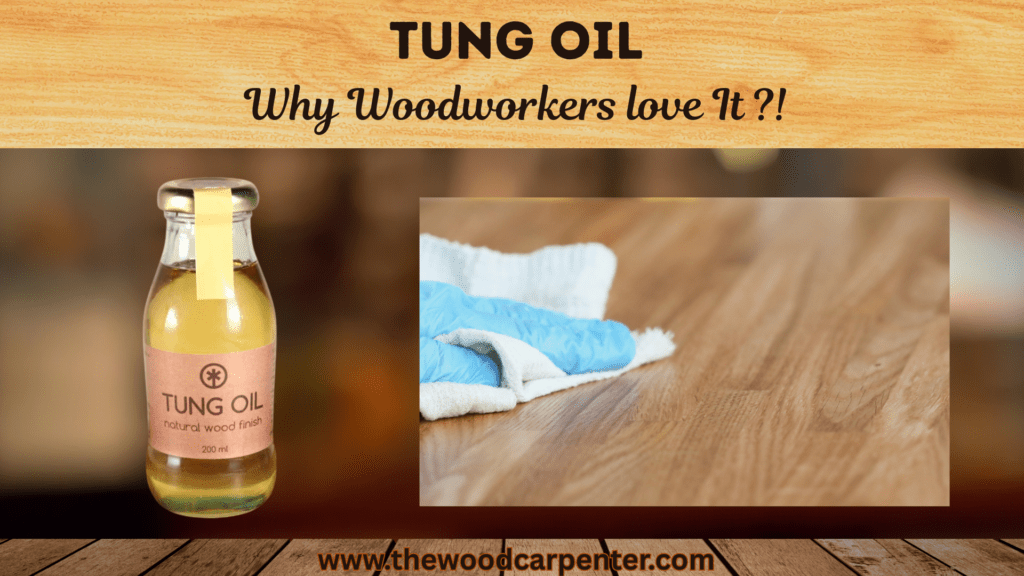
Tung oil is a natural wood finish that has been used for hundreds of years. People love it for its strength, water resistance, and soft matte finish that brings out the natural beauty of wood grain.
It comes from the seeds of the tung tree, which grows in China and in some parts of Asia. Today, it’s a popular choice for woodworkers, craftsmen, and homeowners for protecting both indoor and outdoor wood.
In this guide, we’ll explain what tung oil is, its benefits, how to apply it, how to maintain it, and answer common questions so you can see why it’s still a favorite for wood care.
What Is Tung Oil?
Tung oil is made from the seeds of the tung tree (Aleurites fordii). Unlike oils that just sit on the surface, tung oil soaks deep into the wood fibers. As it dries, it forms a flexible but strong water-resistant layer that protects the wood while keeping a natural matte look.
Tung oil doesn’t turn yellow or change color over time, so the wood’s natural tone stays the same. It’s also 100% natural, non-toxic, and food-safe once fully dry, making it great for kitchen items, cutting boards, countertops, children’s toys, and more.
Composition and Features of Tung Oil
Natural Plant Oil – Pure tung oil is made from the plants and it has no artificial chemicals, VOCs, or harmful additives.
How It Dries – When exposed to air, tung oil changes from a liquid to a tough, flexible solid. This process, called curing, can take several weeks depending on temperature and humidity.
Water Resistance – Once cured, the tung oil forms a waterproof layer that helps to protect wood from moisture, swelling, mold, and mildew.
Flexibility – Because it stays slightly elastic, tung oil moves with the wood as it expands and contracts, helping prevent cracks.
Natural Look – Tung oil highlights the wood grain with a warm, golden color and a soft satin sheen, without looking shiny or plastic.
Benefits of Tung Oil
Strong and Long-Lasting – Tung oil creates a tough, waterproof coating that resists damage from water, alcohol, mild acids, and many household spills.
Safe and Non-Toxic – Once fully cured, it’s safe for use on kitchen items, cutting boards, and children’s toys.
Keeps the Original Color – Unlike some finishes, tung oil doesn’t turn yellow or darken the wood over time.
Breathable Finish – It lets the wood breathe, which reduces problems like peeling or flaking.
Easy to Refresh – You can clean and add another coat without sanding or removing the old finish.
Works on Many Surfaces – Suitable for both hardwoods and softwoods, indoors or outdoors, and even on concrete, stone, or slate.
Common Uses of Tung Oil
- Finished hardwood furniture like tables, chairs, and cabinets
- Butcher blocks, cutting boards, and kitchen countertops
- Wooden utensils and children’s toys
- Outdoor furniture and decks (with adequate maintenance)
- Antique wood restoration
- Protective finishes for marine and boating applications
Related Article:
Tung Oil vs Danish Oil: A Comprehensive Comparison
Teak Oil vs Tung Oil: Which Wood Finish is Best for You?
How to Apply Tung Oil: Step-by-Step
Preparation
- Make sure that the wood is clean, dry and bare—no dirt, dust, grease, or old finishes.
- Sand the surface, starting with coarse grit and then moving to fine grit (150–220) for smoothness.
- Remove all the sanding dust with a vacuum or tack cloth.
Thinning the Oil (Optional but Helpful)
Pure tung oil is thick and dries slowly. Mixing it 50:50 with natural citrus solvent or odorless mineral spirits helps it soak in better, dry faster, and avoid stickiness.
Avoid “green” or eco-labeled mineral spirits—they can cause problems with the finish.
Applying Tung Oil
- Apply a generous amount with a brush, rag or a foam applicator, following the wood grain.
- Let it soak in for 30–45 minutes.
- Wipe off all extra oil with a clean, lint-free cloth so it doesn’t get sticky.
- Let the wood dry for 24–48 hours in a cool, well-ventilated area—keep it out of direct sunlight.
Multiple Coats
- Apply and dry 3–5 coats for most projects, depending on how absorbent the wood is and how much protection you need.
- For floors or heavy-use furniture, add more coats for maximum durability.
- Keep adding coats until the surface stays shiny for at least 40 minutes after oiling—this means the wood is fully saturated.
Curing
- Tung oil fully hardens in 15–30 days.
- During this time, avoid heavy use, placing items on the surface, or exposing it to moisture or sunlight.
- Check for extra oil rising to the surface in the first 10 days and wipe it away.
Maintenance of Tung Oil Finished Surfaces
- Regular cleaning with a mild soap and water is sufficient.
- To refresh or repair worn areas, clean and apply thin coats of tung oil without sanding.
- Outdoor surfaces may require annual reapplication depending on exposure to elements.
Frequently Asked Questions (FAQs)
1. What’s the difference between tung oil and linseed oil?
Tung oil dries faster, is more water-resistant, creates a harder and more flexible finish, and doesn’t turn yellow like linseed oil.
Linseed Oil: 8 Reasons to Think Twice Before Using It
2. Is tung oil safe for food contact?
Yes. Pure tung oil is completely natural and non-toxic once fully cured, so it’s great for kitchen surfaces, cutting boards, and utensils.
3. How long does tung oil take to dry and cure?
It usually dries in 24–48 hours. Full curing (hardening) takes 2–4 weeks.
4. Can I use tung oil on top of other finishes?
It works best on clean, bare wood or over existing tung oil layers. Don’t apply it over varnish or polyurethane.
5. Does tung oil make wood waterproof?
Yes. Once it’s cured, it forms a water-resistant barrier inside the wood. But for outdoor use, you’ll need to reapply it regularly.
6. How many coats do I need?
Most furniture needs 3–5 coats. Floors or heavy-use items may need more. Keep applying until the surface stays shiny for at least 40 minutes after oiling.
7. Can I use tung oil on outdoor furniture?
Yes, but it will need more frequent re-coating and protection from extreme weather.
8. Will tung oil yellow over time?
No. It keeps the natural color of the wood without yellowing or darkening.
9. Can I make it dry faster?
Yes. Mix it with citrus solvent or mineral spirits to help it soak in and dry faster. Don’t use chemical dryers.
10. What’s the best way to apply it?
Use a natural bristle brush, foam brush, or a soft lint-free cloth for an even coat.
Advantages and Considerations
| Advantages | Considerations |
| 100% natural & non-toxic | Slow drying and curing time |
| Water-resistant & durable | Requires multiple coats and patience |
| Food safe when cured | Needs regular maintenance outdoors |
| Enhances natural wood grain | Not a film finish; no glossy shine |
| Flexible and elastic | Surface must be wiped clean after each coat |
| Easy maintenance | Not suitable over synthetic finishes |
Final Thoughts
Tung oil is one of the most trusted and attractive natural finishes for wood. It’s waterproof, safe for food, and brings out the natural beauty of the grain. While it takes time to apply and fully cure, the rich, warm, and lasting finish is worth the effort.
Whether you’re finishing a handmade table, restoring an antique, or protecting outdoor furniture, tung oil can keep your wood looking beautiful and protected for years. With careful preparation, steady application, and proper upkeep, you can enjoy the full benefits of this timeless wood finish.

